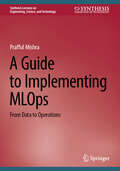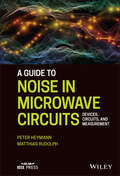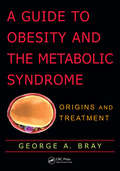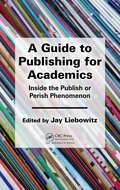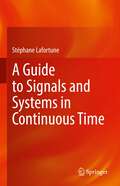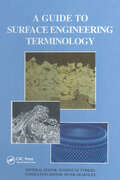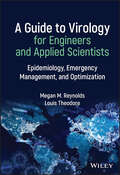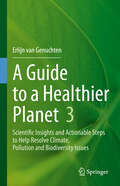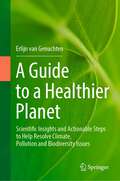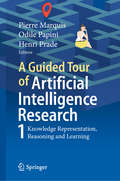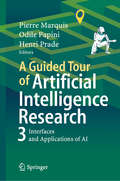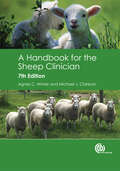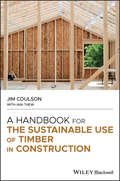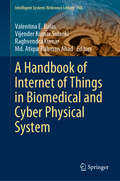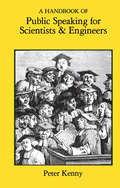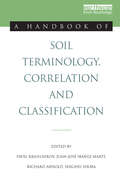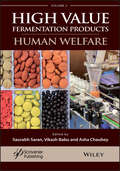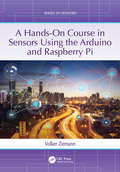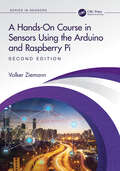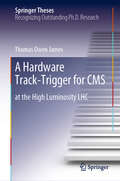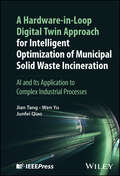- Table View
- List View
A Guide to Implementing MLOps: From Data to Operations (Synthesis Lectures on Engineering, Science, and Technology)
by Prafful MishraOver the past decade, machine learning has come a long way, with organisations of all sizes exploring its potential to extract valuable insights from data. However, despite the promise of machine learning, many organisations need help deploying and managing machine learning models in production. This is where MLOps comes in. MLOps, or machine learning operations, is an emerging field that focuses on the deployment, management, and monitoring of machine learning models in production environments. MLOps combines the principles of DevOps with the unique requirements of machine learning, enabling organisations to build and deploy models at scale while maintaining high levels of reliability and accuracy. This book is a comprehensive guide to MLOps, providing readers with a deep understanding of the principles, best practices, and emerging trends in the field. From training models to deploying them in production, the book covers all aspects of the MLOps process, providing readers with the knowledge and tools they need to implement MLOps in their organisations. The book is aimed at data scientists, machine learning engineers, and IT professionals who are interested in deploying machine learning models at scale. It assumes a basic understanding of machine learning concepts and programming, but no prior knowledge of MLOps is required. Whether you're just getting started with MLOps or looking to enhance your existing knowledge, this book is an essential resource for anyone interested in scaling machine learning in production.
A Guide to Innovation Processes and Solutions for Government
by Gregory C. McLaughlin DBA William R. Kennedy DBAThis book provides a roadmap for successful implementation of innovation for organizations working as subcontractors or suppliers for the federal government. With a focus on the federal sector, it details tools and processes that can make significant improvements in how the federal sector handles innovation opportunities. Presenting insights that can help readers bridge the gap between supplier and customer, the book includes many examples and a case study that illustrate the application of the methodology. It also includes process flowcharts, tools, and strategies for innovation within an agency or organization.
A Guide to Noise in Microwave Circuits: Devices, Circuits and Measurement
by Matthias Rudolph Peter HeymannA GUIDE TO NOISE IN MICROWAVE CIRCUITS A fulsome exploration of critical considerations in microwave circuit noise In A Guide to Noise in Microwave Circuits: Devices, Circuits, and Measurement, a team of distinguished researchers deliver a comprehensive introduction to noise in microwave circuits, with a strong focus on noise characterization of devices and circuits. The book describes fluctuations beginning with their physical origin and touches on the general description of noise in linear and non-linear circuits. Several chapters are devoted to the description of noise measurement techniques and the interpretation of measured data. A full chapter is dedicated to noise sources as well, including thermal, shot, plasma, and current. A Guide to Noise in Microwave Circuits offers examples of measurement problems—like low noise block (LNB) of satellite television – and explores equipment and measurement methods, like the Y, cold source, and 7-state method. This book also includes: A thorough introduction to foundational terms in microwave circuit noise, including average values, amplitude distribution, autocorrelation, cross-correlation, and noise spectra Comprehensive explorations of common noise sources, including thermal noise, the Nyquist formula and thermal radiation, shot noise, plasma noise, and more Practical discussions of noise and linear networks, including narrowband noise In-depth examinations of calculation methods for noise quantities, including noise voltages, currents, and spectra, the noise correlation matrix, and the noise of simple passive networks Perfect for graduate students specializing in microwave and wireless electronics, A Guide to Noise in Microwave Circuits: Devices, Circuits, and Measurement will also earn a place in the libraries of professional engineers working in microwave or wireless circuits and system design.
A Guide to Obesity and the Metabolic Syndrome: Origins and Treatment
by George A. BrayIn the historical record there is abundant evidence that obesity was a medical and health concern as long as medicine has been practiced. The idea of diet and exercise are bulwarks in the fight against obesity in history from the time of Hippocrates to the 16th century-a span of 2,000 years. Examining the history and etiology of the obesity epidemic, this book discusses various requirements of effective intervention and treatment strategies. The first section covers the history of obesity, defines and evaluates the clinical presentation of the pathology, discusses its prevalence in the population, and explains common analytical measurements. Chapters include genetics and genetic factors, modern consequences of obesity, and quality of life issues. The second section introduces prevention strategies in children and adults, such as dietary and lifestyle changes, medication, and surgical interventions.
A Guide to Online Course Design: Strategies for Student Success
by Tina Stavredes Tiffany HerderA Guide to Online Course Design offers faculty and professional staff a practical and easy-to-follow model for creating exceptional online courses that focuses on quality standards in instructional design, transparency in learning outcomes, and learner persistence. A comprehensive resource, the book includes effective, research-based instructional strategies to motivate online learners and help them become more self-directed. A Guide to Online Course Design emphasizes quality standards and removing barriers to learners’ persistence, which ensures online courses meet the needs of online learners as well as distance education initiatives. “All faculty members and course designers, regardless of experience level, content background, or technology skills, can benefit from applying the approaches defined in this book. The authors have imparted a wealth of knowledge that can improve the quality of any online class and I highly recommend this book for all those involved with online learning.” - Anton G. Camarota, faculty, University of Denver “Anyone involved in developing online courses should read this book! Packed with great insights and the research to back them up, Stavredes and Herder guide readers with practical information that will support online course development.” - Brenda Boyd, director of professional development and consulting, Quality Matters Program “The blend of theory and application makes A Guide to Online Course Design and indispensable resource for any professional seeking to create high quality, outcomes-based learning experiences. I loved the action steps that close each chapter, as they lead the reader through the entire process of course design from analysis to implementation.” - Kathe Kacheroski, dean of curriculum and instruction, Rasmussen College
A Guide to Publishing for Academics: Inside the Publish or Perish Phenomenon
by Jay LiebowitzMost academics still wrestle with the "publish or perish" phenomenon. Based on Dr. Liebowitz's 25 years serving as the editor-in-chief of a leading international journal, along with insights from some of the most knowledgeable journal editors, this book shares key lessons learned to help new professors, doctoral students, and practitioner-scholars
A Guide to Signals and Systems in Continuous Time
by Stéphane LafortuneThis textbook is a concise yet precise supplement to traditional books on Signals and Systems, focusing exclusively on the continuous-time case. Students can use this guide to review material, reinforce their understanding, and see how all the parts connect together in a uniform treatment focused on mathematical clarity. Readers learn the “what”, “why” and “how” about the ubiquitous Fourier and Laplace transforms encountered in the study of linear time-invariant systems in engineering: what are these transforms, why do we need them, and how do we use them? Readers will come away with an understanding of the gradual progression from time-domain analysis to frequency-domain and s-domain techniques for continuous-time linear time-invariant systems. This book reflects the author’s experience in teaching this material for over 25 years in sophomore- and junior-level required engineering courses and is ideal for undergraduate classes in electrical engineering.
A Guide to Surface Engineering Terminology
by Eugeniusz TyrkielFirst published in 1995. The International Federation for the Heat Treatment of Materials was founded in 1971. The name was modified in 1986 to International Federation for Heat Treatment and Surface Engineering, but the acronym IFHT was retained. The objective of IFHT is to serve as the premier organisation for facilitating and promoting the international exchange of information in the science and technology of heat treatment and surface engineering. Its particular strength is its effectiveness as a forum uniting science and industry. Surface Engineering is now accepted as a discipline in its own right. This work strives to be more than a mere collection of definitions. Wherever possible the guide expands to provide greater technical detail and, where appropriate, cited further references and application examples. It is hoped that the book will serve as an informative quick reference guide that will prove valuable to the expert and non-expert alike.
A Guide to Virology for Engineers and Applied Scientists: Epidemiology, Emergency Management, and Optimization
by Louis Theodore Megan M. ReynoldsA Guide to Virology for Engineers and Applied Scientists A hands-on guide covering the fundamentals of virology written from an engineering perspective In A Guide to Virology for Engineers and Applied Scientists: Epidemiology, Emergency Management, and Optimization, a team of distinguished researchers delivers a robust and accessible treatment of virology from an engineering perspective. The book synthesizes a great deal of general information on viruses—including coronaviruses—in a single volume. It provides critical context that engineers and applied scientists can use to evaluate and manage viruses encountered in the environment. The fundamental principles of virology are explored with calculation details for health and hazard risk assessments. Each chapter combines numerous illustrative examples and sample problems ideal for advanced courses in environmental health and safety, pharmaceuticals, and environmental science and engineering. Readers will also find: A detailed introduction to health and hazard risk analysis and assessment that is complete with technical information and calculation details Comprehensive illustrative examples and practice problems for use by educators and professionals in training Practical discussions of virology by authors with combined experience in pharmaceuticals and environmental health and safety Thorough treatments of virology from the perspective of a professional engineer A definitive source for those working in related fields who wish to deepen their overall understanding of viruses Perfect for chemical, civil, mechanical, biochemical engineers, and applied scientists, A Guide to Virology for Engineers and Applied Scientists: Epidemiology, Emergency Management, and Optimization will also earn a place in the libraries of industrial hygiene professionals and instructors, students, and practitioners in environmental health, pharmaceuticals, public health, and epidemiology.
A Guide to a Healthier Planet 3: Scientific Insights and Actionable Steps to Help Resolve Climate, Pollution and Biodiversity Issues
by Erlijn van GenuchtenThis successor volume builds upon the previous books with additional chapters meant to inspire readers to take action towards a healthier planet. It focuses on closing the gap between scientific insights on pressing environmental issues that do not often reach the general public, and putting that scientific knowledge in the hands of everyday people who can use these insights to take action against climate change, pollution, and biodiversity loss. The goal of this work is to share fascinating facts about nature and sustainability to inspire taking action toward a healthier planet, and to provide ideas on how we can take action to solve environmental issues in an informed and easy-to-understand way. All chapters are based on open-access research articles covering various environmental issues and solutions that are not often disseminated in popular discourse but are nonetheless important for non-scientific audiences to understand and become familiar with. They allow readers to explore the broad range of concepts and issues and recognize the far-reaching consequences, and trigger the desire to take action. Also, each chapter provides concrete ideas of how we as individuals can take action in daily life to make a positive difference related to the issues described. The book is a multimodal work, as it includes images and videos that accompany the text.
A Guide to a Healthier Planet, Volume 2: Scientific Insights and Actionable Steps to Help Resolve Climate, Pollution and Biodiversity Issues
by Erlijn van GenuchtenThis successor volume builds upon the first book with additional chapters meant to inspire readers to take action towards a healthier planet. It focuses on closing the gap between scientific insights on pressing environmental issues that do not often reach the general public, and putting that scientific knowledge in the hands of everyday people who can use these insights to take action against climate change, pollution, and biodiversity loss. The goal of this work is to share fascinating facts about nature and sustainability to inspire taking action toward a healthier planet, and to provide ideas on how we can take action to solve environmental issues in an informed and easy-to-understand way. The chapters are sourced from the author's work published on medium.com/@ErlijnG with added content not available on medium.com.All chapters are based on open-access research articles covering various environmental issues and solutions that are not often disseminated in popular discourse but are nonetheless important for non-scientific audiences to understand and become familiar with. They allow readers to explore the broad range of concepts and issues and recognize the far-reaching consequences, and trigger the desire to take action. Also, each chapter provides concrete ideas of how we as individuals can take action in daily life to make a positive difference related to the issues described. The book is a multimodal work, as it includes images and videos that accompany the text.
A Guide to a Healthier Planet: Scientific Insights and Actionable Steps to Help Resolve Climate, Pollution and Biodiversity Issues
by Erlijn van GenuchtenThis book focuses on closing the gap between scientific insights on pressing environmental issues that do not often reach the general public, and putting that scientific knowledge in the hands of everyday people who can use these insights to take action against climate change, pollution, and biodiversity loss. The goal of this work is to share fascinating facts about nature and sustainability to inspire taking action toward a healthier planet, and to provide ideas on how we can take action to solve environmental issues in an informed and easy-to-understand way. The chapters are sourced from the author's work published on medium.com/@ErlijnG with added content not available on medium.com.All chapters are based on open-access research articles covering various environmental issues and solutions that are not often disseminated in popular discourse but are nonetheless important for non-scientific audiences to understand and become familiar with. They allow readers to explore the broad range of concepts and issues and recognize the far-reaching consequences, and trigger the desire to take action. Also, each chapter provides concrete ideas of how we as individuals can take action in daily life to make a positive difference related to the issues described. The book is a multimodal work, as it includes images and videos that accompany the text.
A Guided Tour of Artificial Intelligence Research: Volume I: Knowledge Representation, Reasoning and Learning
by Henri Prade Pierre Marquis Odile PapiniThe purpose of this book is to provide an overview of AI research, ranging from basic work to interfaces and applications, with as much emphasis on results as on current issues. It is aimed at an audience of master students and Ph.D. students, and can be of interest as well for researchers and engineers who want to know more about AI. The book is split into three volumes: - the first volume brings together twenty-three chapters dealing with the foundations of knowledge representation and the formalization of reasoning and learning (Volume 1. Knowledge representation, reasoning and learning) - the second volume offers a view of AI, in fourteen chapters, from the side of the algorithms (Volume 2. AI Algorithms) - the third volume, composed of sixteen chapters, describes the main interfaces and applications of AI (Volume 3. Interfaces and applications of AI). Implementing reasoning or decision making processes requires an appropriate representation of the pieces of information to be exploited. This first volume starts with a historical chapter sketching the slow emergence of building blocks of AI along centuries. Then the volume provides an organized overview of different logical, numerical, or graphical representation formalisms able to handle incomplete information, rules having exceptions, probabilistic and possibilistic uncertainty (and beyond), as well as taxonomies, time, space, preferences, norms, causality, and even trust and emotions among agents. Different types of reasoning, beyond classical deduction, are surveyed including nonmonotonic reasoning, belief revision, updating, information fusion, reasoning based on similarity (case-based, interpolative, or analogical), as well as reasoning about actions, reasoning about ontologies (description logics), argumentation, and negotiation or persuasion between agents. Three chapters deal with decision making, be it multiple criteria, collective, or under uncertainty. Two chapters cover statistical computational learning and reinforcement learning (other machine learning topics are covered in Volume 2). Chapters on diagnosis and supervision, validation and explanation, and knowledge base acquisition complete the volume.
A Guided Tour of Artificial Intelligence Research: Volume II: AI Algorithms
by Henri Prade Pierre Marquis Odile PapiniThe purpose of this book is to provide an overview of AI research, ranging from basic work to interfaces and applications, with as much emphasis on results as on current issues. It is aimed at an audience of master students and Ph.D. students, and can be of interest as well for researchers and engineers who want to know more about AI. The book is split into three volumes: - the first volume brings together twenty-three chapters dealing with the foundations of knowledge representation and the formalization of reasoning and learning (Volume 1. Knowledge representation, reasoning and learning) - the second volume offers a view of AI, in fourteen chapters, from the side of the algorithms (Volume 2. AI Algorithms) - the third volume, composed of sixteen chapters, describes the main interfaces and applications of AI (Volume 3. Interfaces and applications of AI). This second volume presents the main families of algorithms developed or used in AI to learn, to infer, to decide. Generic approaches to problem solving are presented: ordered heuristic search, as well as metaheuristics are considered. Algorithms for processing logic-based representations of various types (first-order formulae, propositional formulae, logic programs, etc.) and graphical models of various types (standard constraint networks, valued ones, Bayes nets, Markov random fields, etc.) are presented. The volume also focuses on algorithms which have been developed to simulate specific ‘intelligent” processes such as planning, playing, learning, and extracting knowledge from data. Finally, an afterword draws a parallel between algorithmic problems in operation research and in AI.
A Guided Tour of Artificial Intelligence Research: Volume III: Interfaces and Applications of Artificial Intelligence
by Henri Prade Pierre Marquis Odile PapiniThe purpose of this book is to provide an overview of AI research, ranging from basic work to interfaces and applications, with as much emphasis on results as on current issues. It is aimed at an audience of master students and Ph.D. students, and can be of interest as well for researchers and engineers who want to know more about AI. The book is split into three volumes: - the first volume brings together twenty-three chapters dealing with the foundations of knowledge representation and the formalization of reasoning and learning (Volume 1. Knowledge representation, reasoning and learning) - the second volume offers a view of AI, in fourteen chapters, from the side of the algorithms (Volume 2. AI Algorithms) - the third volume, composed of sixteen chapters, describes the main interfaces and applications of AI (Volume 3. Interfaces and applications of AI). This third volume is dedicated to the interfaces of AI with various fields, with which strong links exist either at the methodological or at the applicative levels. The foreword of this volume reminds us that AI was born for a large part from cybernetics. Chapters are devoted to disciplines that are historically sisters of AI: natural language processing, pattern recognition and computer vision, and robotics. Also close and complementary to AI due to their direct links with information are databases, the semantic web, information retrieval and human-computer interaction. All these disciplines are privileged places for applications of AI methods. This is also the case for bioinformatics, biological modeling and computational neurosciences. The developments of AI have also led to a dialogue with theoretical computer science in particular regarding computability and complexity. Besides, AI research and findings have renewed philosophical and epistemological questions, while their cognitive validity raises questions to psychology. The volume also discusses some of the interactions between science and artistic creation in literature and in music. Lastly, an epilogue concludes the three volumes of this Guided Tour of AI Research by providing an overview of what has been achieved by AI, emphasizing AI as a science, and not just as an innovative technology, and trying to dispel some misunderstandings.
A Handbook for the Sheep Clinician
by Agnes Winter Michael ClarksonAn established favourite with veterinary and agricultural students and a valuable addition to the library of any veterinarian or sheep farmer, this handbook covers the basics of sheep medicine and production. Geared at being an on-farm reference, it concisely conveys all of the fundamental information for the treatment of sheep worldwide. In this fully updated and revised 7th edition, topics covered include reproduction, vaccination, pregnancy and newborns, lameness, parasites, diseases, neurology and health promotion. An emphasis on diagnosis and treatment combined with short, easily digestible chapters and step-by-step diagrams makes this book an essential practical guide to recognising, treating and preventing disease.
A Handbook for the Sustainable Use of Timber in Construction
by Jim CoulsonThere is a growing interest in the use of wood in new building, not least because it has low embodied energy and it is an infinitely renewable resource. Despite a great deal of innovation in the use of wood in construction in recent years, the fundamentals of using this natural material have not really changed: the different types of wood have different properties and differing responses to the environment in which they are used. When used correctly, wood is an excellent building material but when inappropriately specified or used, it may cause problems. Poor understanding of the properties of wood and the many species and grades that are commercially available can result in this versatile material performing below expectation, and certainly less well than could have been achieved with greater understanding about how best to use it. How Wood Works is a combination of the author's two previous books, into one comprehensive volume. Revised and updated material to deal with the essentials of structural design and building in timber, in a sustainable manner while reflecting on changes in Standards and other Regulations and expanding on certain technical areas – such as more detailed wood science and wood structure.
A Handbook of Internet of Things in Biomedical and Cyber Physical System (Intelligent Systems Reference Library #165)
by Raghvendra Kumar Valentina E. Balas Vijender Kumar Solanki Md. Atiqur Rahman AhadThis book presents a compilation of state-of-the-art work on biomedical and cyber-physical systems in connection with the Internet of Things, and successfully blends theory and practice. The book covers the studies belonging to Biomedical and Cyber-physical System, so it is a unique effort by the research experts, who are divulging in the domain deeply. The book is very easy for the audience, who are doing study in the Biomedical and Cyber-physical System; it helps to read some real-time scenarios from where the reader in general gets many sparking ideas to convert it into the research problems in their studies. This book is of use to solve down the problems of graduate, postgraduate, doctoral industry executives, who are involving in the cutting-edge work of Internet of Things with Biomedical or Cyber-physical System, with the help of real-time solutions, given in the formation of chapters by subject’s experts.The key uses of this book are in the area of Internet of Things in connection with Cyber-physical System as well as Biomedical domain.
A Handbook of Public Speaking for Scientists and Engineers
by Peter KennyA Handbook of Public Speaking for Scientists and Engineers helps scientists and engineers improve their skills at speaking in public in the course of their professional activities. The book shows how best to prepare papers for presentation at a technical conference and how to put cases to committee meetings. Not only does the book deal with specific events, but it also provides the techniques of more effective speaking, whether presenting papers, answering questions, or speaking "off-the-cuff." The book is written in a highly entertaining manner and should put all complacent lecturers on their guard.
A Handbook of Soil Terminology, Correlation and Classification
by Richard Arnold Serghei ShobaSoil classification and terminology are fundamental issues for the clear understanding and communication of the subject. However, while there are many national soil classification systems, these do not directly correlate with each other. This leads to confusion and great difficulty in undertaking comparative scientific research that draws on more than one system and in making sense of international scientific papers using a system that is unfamiliar to the reader. This book aims to clarify this position by describing and comparing different systems and evaluating them in the context of the World Reference Base (WRB) for Soil Resources. The latter was set up to resolve these problems by creating an international 'umbrella' system for soil correlation. All soil scientists should then classify soils using the WRB as well as their national systems. The book is a definitive and essential reference work for all students studying soils as part of life, earth or environmental sciences, as well as professional soil scientists. Published with International Union of Soil Sciences
A Handbook on High Value Fermentation Products, Volume 2: Human Welfare
by Vikash Babu Saurabh Saran Asha ChaubeyGreen technologies are no longer the “future” of science, but the present. With more and more mature industries, such as the process industries, making large strides seemingly every single day, and more consumers demanding products created from green technologies, it is essential for any business in any industry to be familiar with the latest processes and technologies. It is all part of a global effort to “go greener,” and this is nowhere more apparent than in fermentation technology. This second volume in the groundbreaking new set, High Value Fermentation Products, focuses on industries that a concerned with human welfare, including the leather industry, textiles, pharmaceutical and medical, food processing, and others. Covering topics such as chitin and chitosan, microbial polyhydroxyalkanoates, propanediol, and many others, the editors and contributors have contributed to an extremely important facet of chemical and process engineering and how to move these industries into a much more sustainable and environmentally conscious direction. From converting waste into apparel to creating healthier foods and more effective medicines, this is truly a monumental work that is a must-have for any chemical engineer, scientist, or chemist.
A Hands-On Course in Sensors Using the Arduino and Raspberry Pi (Series in Sensors)
by Volker ZiemannA Hands-On Course in Sensors using the Arduino and Raspberry Pi is the first book to give a practical and wide-ranging account of how to interface sensors and actuators with micro-controllers, Raspberry Pi and other control systems. The author describes the progression of raw signals through conditioning stages, digitization, data storage and presentation. <P><P>The collection, processing, and understanding of sensor data plays a central role in industrial and scientific activities. This book builds simplified models of large industrial or scientific installations that contain hardware and other building blocks, including services for databases, web servers, control systems, and messaging brokers. A range of case studies are included within the book, including a weather station, geophones, a water-colour monitor, capacitance measurement, the profile of laser beam, and a remote-controlled and fire-seeking robot <P><P>This book is suitable for advanced undergraduate and graduate students taking hands-on laboratory courses in physics and engineering. Hobbyists in robotics clubs and other enthusiasts will also find this book of interest. <P><P>Features: <li>Includes practical, hands-on exercises that can be conducted in student labs, or even at home <li>Covers the latest software and hardware, and all code featured in examples is discussed in detail <li>All steps are illustrated with practical examples and case studies to enhance learning
A Hands-On Course in Sensors Using the Arduino and Raspberry Pi (Series in Sensors)
by Volker ZiemannA Hands-On Course in Sensors Using the Arduino and Raspberry Pi is the first book to give a practical and wide-ranging account of how to interface sensors and actuators with micro-controllers, Raspberry Pi and other control systems. The author describes the progression of raw signals through conditioning stages, digitization, data storage and presentation. The collection, processing, and understanding of sensor data plays a central role in industrial and scientific activities. This book builds simplified models of large industrial or scientific installations that contain hardware and other building blocks, including services for databases, web servers, control systems, and messaging brokers. A range of case studies are included within the book, including a weather station, ground-vibration measurements, impedance measurements, interfacing medical sensors to web browsers, the profile of a laser beam, and a remote-controlled and fire-seeking robot. This second edition has been updated throughout to reflect new hardware and software releases since the book was first published. Newly added features include the ESP32 microcontroller, several environmental and medical sensors, actuators for signal generation, as well as a chapter on web sockets; all illustrated in new case studies. This book is suitable for advanced undergraduate and graduate students taking hands-on laboratory courses in physics and engineering. Hobbyists in robotics clubs and other enthusiasts will also find this book of interest. Features: Includes practical, hands-on exercises that can be conducted in student labs, or even at home Covers the latest software and hardware, and all code featured in examples is discussed in detail All steps are illustrated with practical examples and case studies to enhance learning https://github.com/volkziem/HandsOnSensors2ed Volker Ziemann obtained his PhD in accelerator physics from Dortmund University in 1990. After post-doctoral positions in Stanford at SLAC and in Geneva at CERN, where he worked on the design of the LHC, in 1995 he moved to Uppsala where he worked at the electron-cooler storage ring CELSIUS. In 2005 he moved to the physics department where he has since taught physics. He was responsible for several accelerator physics projects at CERN, DESY and XFEL. In 2014 he received the Thuréus prize from the Royal Society of Sciences in Uppsala.
A Hardware Track-Trigger for CMS: at the High Luminosity LHC (Springer Theses)
by Thomas Owen JamesThe work described in this PhD thesis is a study of a real implementation of a track-finder system which could provide reconstructed high transverse momentum tracks to the first-level trigger of the High Luminosity LHC upgrade of the CMS experiment. This is vital for the future success of CMS, since otherwise it will be impossible to achieve the trigger selectivity needed to contain the very high event rates. The unique and extremely challenging requirement of the system is to utilise the enormous volume of tracker data within a few microseconds to arrive at a trigger decision.The track-finder demonstrator described proved unequivocally, using existing hardware, that a real-time track-finder could be built using present-generation FPGA-based technology which would meet the latency and performance requirements of the future tracker. This means that more advanced hardware customised for the new CMS tracker should be even more capable, and will deliver very significant gains for the future physics returns from the LHC.
A Hardware-in-Loop Digital Twin Approach for Intelligent Optimization of Municipal Solid Waste Incineration: AI and Its Application to Complex Industrial Processes
by Wen Yu Jiang Tang Junfei QiaoAn expert discussion of intelligent optimization control in complex industrial processes In A Hardware-in-Loop Digital Twin Approach for Intelligent Optimization of Municipal Solid Waste Incineration: AI and Its Application to Complex Industrial Processes, a team of distinguished researchers delivers an innovative new approach to integrating virtual mechanism data generated through coupled numerical simulation and orthogonal experimental design with real historical data. The book explains how to create a heterogenous ensemble prediction model for carbon monoxide emissions in municipal solid waste incineration (MSWI) processes. The authors focus on intelligent optimization control of MSWI processes based on hardware-in-loop DT platforms. They demonstrate AI-driven modeling, control, optimization algorithms in real-world applications, including virtual-real data hybrid-driven deep modeling and intelligent optimal controls based on multiple objectives. Additional topics include: A thorough introduction to numerical simulation modeling of whole industrial processesComprehensive explorations of the design, implementation, and validation of hardware-in-loop digital twin platformsPractical discussions of AI-driven modeling, control, and optimizationFulsome descriptions of the skills required to address challenges posed by complex industrial processes Perfect for environmental engineers and researchers, A Hardware-in-Loop Digital Twin Approach for Intelligent Optimization of Municipal Solid Waste Incineration will also benefit MSWI plant operators and managers, as well as AI and machine learning researchers and developers of environmental monitoring and control systems.
